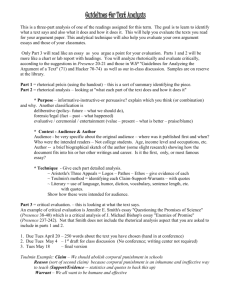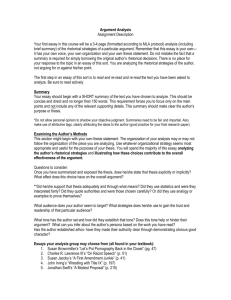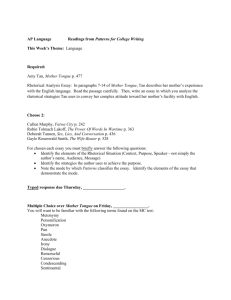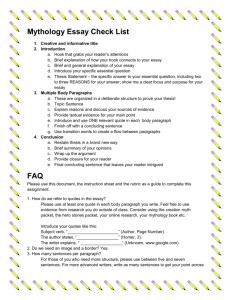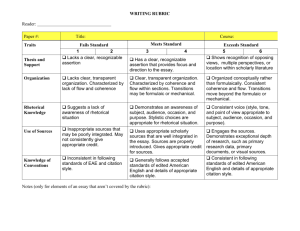Instructor: Jenna Alexander ENGL 3100 Unit 2: Academic Analysis
advertisement
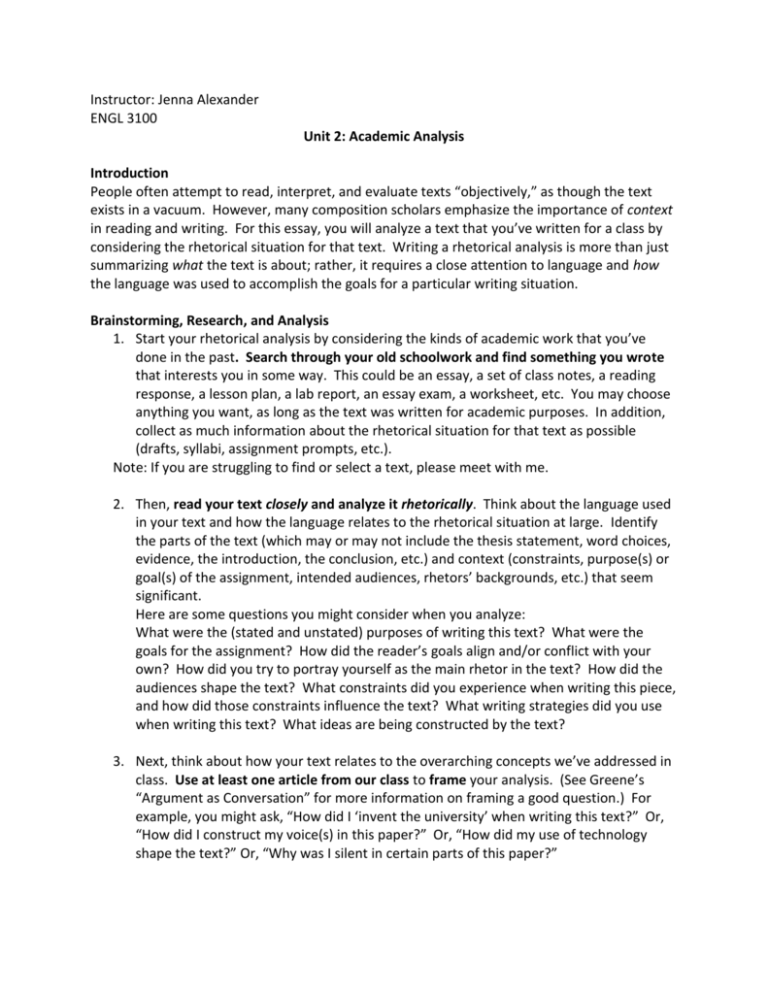
Instructor: Jenna Alexander ENGL 3100 Unit 2: Academic Analysis Introduction People often attempt to read, interpret, and evaluate texts “objectively,” as though the text exists in a vacuum. However, many composition scholars emphasize the importance of context in reading and writing. For this essay, you will analyze a text that you’ve written for a class by considering the rhetorical situation for that text. Writing a rhetorical analysis is more than just summarizing what the text is about; rather, it requires a close attention to language and how the language was used to accomplish the goals for a particular writing situation. Brainstorming, Research, and Analysis 1. Start your rhetorical analysis by considering the kinds of academic work that you’ve done in the past. Search through your old schoolwork and find something you wrote that interests you in some way. This could be an essay, a set of class notes, a reading response, a lesson plan, a lab report, an essay exam, a worksheet, etc. You may choose anything you want, as long as the text was written for academic purposes. In addition, collect as much information about the rhetorical situation for that text as possible (drafts, syllabi, assignment prompts, etc.). Note: If you are struggling to find or select a text, please meet with me. 2. Then, read your text closely and analyze it rhetorically. Think about the language used in your text and how the language relates to the rhetorical situation at large. Identify the parts of the text (which may or may not include the thesis statement, word choices, evidence, the introduction, the conclusion, etc.) and context (constraints, purpose(s) or goal(s) of the assignment, intended audiences, rhetors’ backgrounds, etc.) that seem significant. Here are some questions you might consider when you analyze: What were the (stated and unstated) purposes of writing this text? What were the goals for the assignment? How did the reader’s goals align and/or conflict with your own? How did you try to portray yourself as the main rhetor in the text? How did the audiences shape the text? What constraints did you experience when writing this piece, and how did those constraints influence the text? What writing strategies did you use when writing this text? What ideas are being constructed by the text? 3. Next, think about how your text relates to the overarching concepts we’ve addressed in class. Use at least one article from our class to frame your analysis. (See Greene’s “Argument as Conversation” for more information on framing a good question.) For example, you might ask, “How did I ‘invent the university’ when writing this text?” Or, “How did I construct my voice(s) in this paper?” Or, “How did my use of technology shape the text?” Or, “Why was I silent in certain parts of this paper?” 4. Using your analysis notes and research question, provide a 4-6 page answer to this research question. In other words, you’ll formulate an argument about writing in academic situations, using your text and personal experiences as evidence. This argument may support, refute, develop and/or challenge the ideas that you’ve encountered in the assigned readings. Regardless, you should contribute in a significant way to the scholarly conversations you’ve encountered in the assigned articles. Goals The goals of this assignment are (one) to analyze an example of your academic writing rhetorically and (two) to become conversant with several theoretical issues that concern composition scholars and teachers. The Process and Writing Calendar Wednesday, October 22 – Friday, October 24 – First draft or evidence of pre-writing due at your conference Wednesday, October 22 – Friday, October 24 – Conferences Thursday, October 30 – Second draft due Tuesday, November 4 – Portfolio 2 due (along with the final draft of Paper 2) Rubric/Requirements Structure/Organization: o Follow prompt, use approved topic o Clear, focused purpose o Well-written thesis, represents essay in entirety o Brief summary of the original text to help the reader(s) understand the example o Brief summary of the scholarly source to help the reader(s) understand the debate o Introduction is attention-getting o Sets context, motive and criteria for analysis o Introduces the sources by providing relevant background information (author, title) o Clear organization that emphasizes content and strategies for development o Each paragraph clearly fits with purpose of essay o Paragraphs are structured clearly (MEAL Plan) o Utilizes effective transitions between main ideas and paragraphs (flows well) o Resolution/conclusion Development/Detail: o Analysis is clear and fully explained o Analysis demonstrates depth of thought, going beyond surface meaning for each example o Each main point (paragraph) analyzes specific detail from text and connects to thesis o Quotes are smoothly worked into paragraph, not dropped in o Quotes and support from text are fully explained in connection to thesis o Essay demonstrates a certain level of maturity, professionalism and appropriateness o Makes significant revisions from draft to draft, not just sentence-level changes Polish: o Grammar o Active verbs, present tense o Clarity o Sentence structure and variety o Punctuation—commas, colons, dashes and semi-colons o Mechanics


